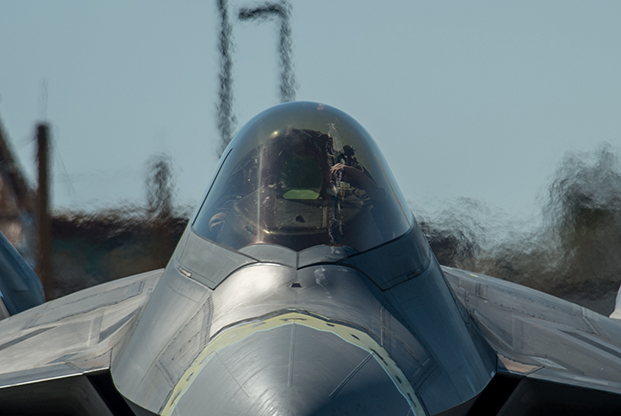
USAF F-22 Raptors flown by pilots from the 94th and 149th Fighter Squadrons take off from Tyndall AFB, Fla., on Oct. 30. Air Force photo by SrA. Sean Carnes.
TYNDALL AFB, Fla. — The most badly damaged F-22s are now flyable and will depart here within days as more than 1,300 airmen work to bring Tyndall back from the brink following one of the most powerful storms in history.
Seventeen F-22s remained at Tyndall as Hurricane Michael ripped through the base almost three weeks ago, with many officials here initially thinking there was no way Tyndall could come back from the blow. More than 95 percent of buildings on the base were damaged and almost all of the pine trees surrounding the flight line are snapped in half. The 325th Fighter Wing Commander Col. Brian Laidlaw told Air Force Magazine during a visit to the base this week that the damage was “surreal.”
Initial reports focused on the Raptors that remained, many of which rode out the storm in Hangar 5 on the East end of the flight line, which lost its roof in the storm. Air Force officials originally feared some of the Raptors might not fly again, but the service brought in experts and “methodically” removed the aircraft from their hangars. Airmen built three inflatable temporary hangars directly on the flight line, and the F-22s were towed there for assessment. Two F-22s took off for JB Langley-Eustis, Va., on Tuesday afternoon. Air Force Magazine saw two more Raptors in separate hangars at Tyndall and one more on the flight line Wednesday morning.
A minor storm was bearing down on the base Wednesday, bringing rain, limited winds, and slowing plans, but the final Raptors will leave Tyndall for more in-depth assessment and maintenance at Langley in a matter of days, not weeks, Laidlaw said Wednesday.
This progress is a far cry from initial reports and pictures, which showed the roof of hangars fallen onto F-22s and other aircraft. On Wednesday, focus shifted to the rest of the aircraft in the damaged hangar five. Trucks pulled T-38s, used as adversary aircraft, down the flight line to a separate hangar for assessment. Laidlaw said it is too early to determine the extent of damage to the T-38s or other aircraft, including QF-16 targeting drones and Twin Otter aircraft, until the hangar is cleared and a more detailed assessment is made.
“I like our methodology, and our methodology is to not make a problem any worse than it is,” Laidlaw said.
Debris, once scattered everywhere on streets and the flight line, now sits in large piles across the base. Dozens of tents now house many of the 1,300 airmen who are assessing buildings and bringing basic services back to the base.
Tyndall’s air traffic control tower, while largely intact, had its windows blown out and received water damage, so a small temporary tower sits directly off the runway directing the F-22s out and bringing in airlift aircraft carrying airmen, food, tents, vehicles, and other supplies.
Laidlaw said he is trying to determine what buildings can be saved by getting “eyes on” them all by civil engineers, RED HORSE airmen, and contractors. Many buildings need to be demolished, while others area easily saved. Then there are those “in-between” or “yellow” buildings that need a deeper assessment, he said.
Vice President Mike Pence and Secretary of the Air Force Heather Wilson visited the base last week, where they announced that Tyndall’s F-22 training mission and the 601st Air Operations Center would be back up and running by the beginning of the year. Laidlaw said Wednesday he is working to determine the capacity available to meet that goal by doing everything possible to keep as much of the key infrastructure available.
“The way I see my role as installation commander is to, as smartly as possible, put Band-Aids on every window we can to keep as much in the decision space as possible,” Laidlaw said.
Tyndall has eight full-mission simulators for the F-22 school house, and the building housing those simulators was slightly damaged. There is still work to do, but they should be up and running by the timeline provided by Pence. F-22s will move to nearby Eglin AFB, Fla., for the flying portion of training.
In advance of the storm, Tyndall evacuated 11,000 people from the community and the most important thing is that no one got hurt, Laidlaw said. Many of these airmen have returned to damaged or destroyed homes, and still unanswered questions about their future, but they have proven to be resilient, he said. Squadron commanders are talking to airmen individually to determine the best way to address their concerns and what they need immediately, as a way to avoid broad “one size fits all” plans that would not be as effective, he said.
“They’ve been incredibly patient with us, I appreciate that,” Laidlaw said. “By and large their spirits are high. They are airmen. Airmen are resilient people. We’re going to get through this.”
The base has returned to life at a pace that didn’t seem possible based on the extent of the damage at first, and that is a testament to the speed at which the Air Force responded and the expertise of the specific airmen that arrived. For example, special tactics airmen had no trouble immediately returning the flightline to operations. RED HORSE airmen from Hurlburt Field, Fla., quickly went to work assessing the facilities, clearing debris, and getting operations going. Base defenders, deployed from Moody AFB, Ga., set out to secure a sprawling facility that didn’t even have a fence line remaining after the storm, Laidlaw said.
“I just let them do what they were trained to do, and here we are, three weeks later, and I couldn’t be more impressed by how much progress we’ve made, and I could not be more proud watching them do what they are trained to do,” he said.